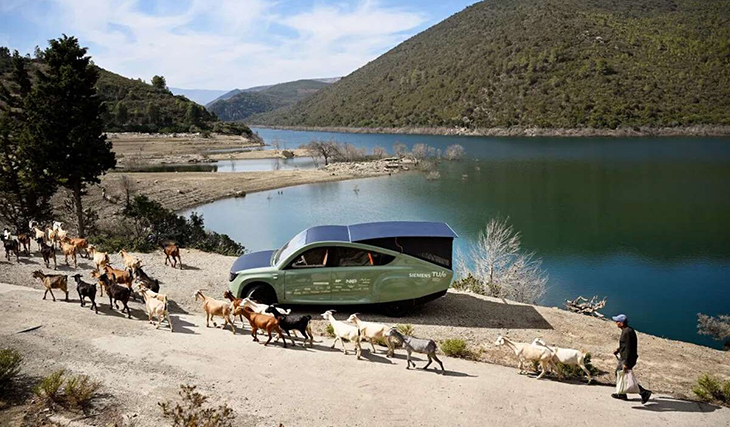
In a bold venture into sustainable transportation, students from Eindhoven University of Technology (TUE) in The Netherlands have unveiled the Stella Terra, a solar-powered SUV with camper van capabilities, conceived as the ultimate concept car for off-grid adventures in sun-soaked environments.
Embarking on a 620-mile (1,000-kilometer) expedition across Morocco, the Stella Terra showcased a plethora of advantages over conventional electric SUVs.
Thieme Bosman, events manager for the TUE team, said, “Morocco has a huge variety of landscapes and different surfaces in quite a short distance.”
He told CNN the car was tested “on every type of surface that a car like this could encounter.”
Distinguishing itself with a wide, sloping roof adorned with built-in solar panels, the Stella Terra ingeniously charges its electric battery while in motion. This groundbreaking feature enabled the designers to reduce the weight of the battery packs significantly, resulting in a lighter vehicle that consumers less electricity for power.
By prioritizing weight reduction and sculpting the body panels for aerodynamic efficiency, the Stella Terra weighs in at a mere 2,465 pounds (1,200 kilograms), approximately 25% less than its electric SUV counterparts.
The emphasis on lightweight construction and aerodynamics contributes to an impressive range of around 710 kilometers (441 miles) on roads and approximately 550 kilometers (342 miles) off-road. The designers took into account variable weather conditions, providing a margin of plus or minus 50 kilometers for cloudy or sunny weather, acknowledging in the notorious unreliability of car manufacturers’ reported ranges.
The team drove if from Tangier through the Rif Mountains, down to Fes and up the high mountain tracks near Midelt, Morocco’s highest town, and back down to the Sahara Desert area where it faced loose sandy tracks.
As the day concluded, the solar array on the rooftop extended outward, maximizing recharging capabilities in the remaining daylight while also transforming into an awning reminiscent of camper vans. The innovative design extends to the seats, which fully recline to form a comfortable bed for the occupants.
Despite encountering a setback with the steering system breaking early in the journey, the TUE team showcased their resourcefulness by repairing it in a countryside workshop using locally sourced parts, underscoring the vehicle’s potential resilience in challenging conditions.
The TUE innovators acknowledge the inherent challenges of bringing such concept cars to the mass-produced market. Questions regarding the ultimate price point, target audience, and optimal marketing locations pose significant hurdles that many concept car manufacturers struggle to overcome.
“We aim to also inspire not only everyday people, but also the automotive industry, the Ford and Chryslers of the world, to think again about their designs and to innovate faster than they currently do,” says Bosman.
“It’s up to the market now, who have the resources and the power to make this change and the switch to more sustainable vehicles.”
However, the creators envision the Stella Terra as an ideal choice for drivers situated far from reliable power grids or emergency workers operating in remote areas. The vehicle’s potential applications extend to transporting critical supplies or medical personnel over multi-day journeys, showcasing its adaptability and functionality in real-world scenarios.
As sustainable transportation solutions continue to evolve, the Stella Terra stands as a testament to the creativity and ingenuity of students pushing the boundaries of eco-friendly mobility.
See more about the innovative Stella Terra in the video below:
What are your thoughts? Please comment below and share this news!
True Activist / Report a typo


